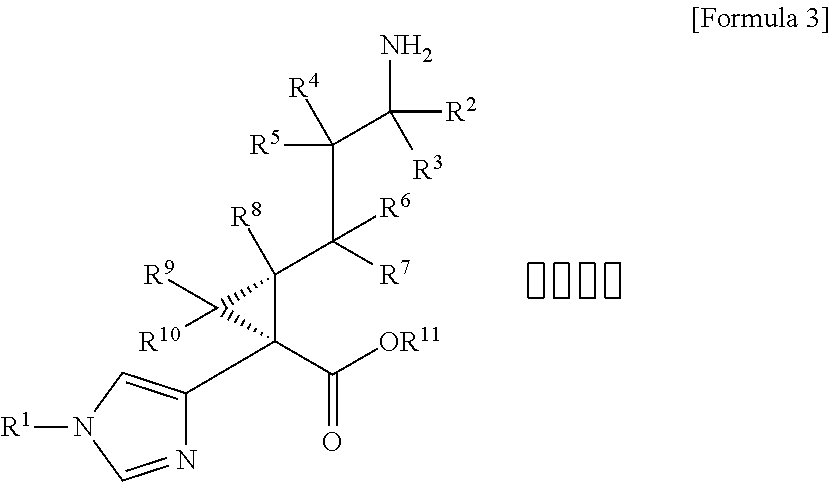Cyclopropanecarboxylic acid derivative
a technology of cyclopropanecarboxylic acid and derivative, which is applied in the direction of antibacterial agents, extracellular fluid disorders, metabolic disorders, etc., can solve the problems that heparin or low-molecular weight heparin cannot be expected to exert drug efficacy in oral administration, and the inhibitors of these enzymes are at risk of potential adverse reactions, etc., to achieve excellent tafia inhibitory activity, excellent pharmacological effect, and good oral absorption
- Summary
- Abstract
- Description
- Claims
- Application Information
AI Technical Summary
Benefits of technology
Problems solved by technology
Method used
Image
Examples
reference example 1
Ethyl[1-(3,3-dimethylbutyl)-1H-imidazol-4-yl]acetate
[0310]
[Step 1] Ethyl 1H-imidazol-4-ylacetate
[0311]1H-Imidazol-4-ylacetic acid hydrochloride (5.00 g) was dissolved in ethanol (100 mL). To the solution, thionyl chloride (2.46 mL) was added at room temperature, and the mixture was then heated to reflux for 3.5 hours. The reaction solvent was distilled off under reduced pressure. To the residue, a saturated aqueous solution of sodium bicarbonate was then added, and organic matter was extracted five times with methylene chloride. The organic layer was dried over anhydrous sodium sulfate and filtered, and the solvent was distilled off under reduced pressure to obtain a crude product of ethyl 1H-imidazol-4-ylacetate (4.10 g).
[0312]1H-NMR (CDCl3) δ: 1.28 (3H, t, J=7.04 Hz), 3.69 (2H, s), 4.19 (2H, q, J=7.04 Hz), 6.98 (1H, s), 7.60 (1H, s).
[Step 2] Ethyl [1-(3,3-dimethylbutyl)-1H-imidazol-4-yl]acetate
[0313]Ethyl 1H-imidazol-4-ylacetate (3.74 g) obtained in Step 1 was dissolved in N,N-dim...
reference example 2
Ethyl 6-[bis(tert-butoxycarbonyl)amino]-2-[1-(3,3-dimethylbutyl)-1H-imidazol-4-yl]-3-hydroxyhexanoate
[0315]
[0316]The compound (443 mg) obtained in Reference Example 1 was dissolved in tetrahydrofuran (10 mL). This solution was cooled to −78° C. Lithium hexamethyldisilazide (LHMDS, 1 N tetrahydrofuran solution, 2.05 mL) was added thereto, and the mixture was stirred for 30 minutes. To this solution, a solution containing di-tert-butyl (4-oxobutyl)imidodicarbonate (Tetrahedron Letters, 1996, vol. 37, p. 3379) (534 mg) in tetrahydrofuran (10 mL) was added, and the mixture was stirred at −78° C. for 45 minutes. This reaction solution was quenched by the addition of a saturated aqueous solution of ammonium chloride and separated into aqueous and organic layers by the addition of water and diisopropyl ether. The obtained organic layer was washed with saturated sodium chloride solution and dried over anhydrous magnesium sulfate. The obtained residue was purified by silica gel chromatograph...
reference example 3
Ethyl (2Z)-6-[bis(tert-butoxycarbonyl)amino]-2-[1-(3,3-dimethylbutyl)-1H-imidazol-4-yl]hex-2-enoate and ethyl (2E)-6-[bis(tert-butoxycarbonyl)amino]-2-[1-(3,3-dimethylbutyl)-1H-imidazol-4-yl]hex-2-enoate
[0319]
[0320]The compound (763 mg) obtained in Reference Example 2 was dissolved in methylene chloride (50 mL). To this solution, triethylamine (0.404 mL), methanesulfonyl chloride (0.168 mL), and 1,8-diazabicyclo[5.4.0]undec-7-ene (0.434 mL) were added at 0° C. The mixture was stirred at room temperature for 5 days and then separated into aqueous and organic layers by the addition of water, a 10% aqueous citric acid solution, and ethyl acetate. The obtained organic layer was washed with saturated sodium chloride solution, a saturated aqueous solution of sodium bicarbonate, and saturated sodium chloride solution in this order and dried over anhydrous magnesium sulfate. The obtained residue was purified by silica gel chromatography (eluting solvent: methylene chloride / ethyl acetate=4 / 1...
PUM
 Login to View More
Login to View More Abstract
Description
Claims
Application Information
 Login to View More
Login to View More - R&D
- Intellectual Property
- Life Sciences
- Materials
- Tech Scout
- Unparalleled Data Quality
- Higher Quality Content
- 60% Fewer Hallucinations
Browse by: Latest US Patents, China's latest patents, Technical Efficacy Thesaurus, Application Domain, Technology Topic, Popular Technical Reports.
© 2025 PatSnap. All rights reserved.Legal|Privacy policy|Modern Slavery Act Transparency Statement|Sitemap|About US| Contact US: help@patsnap.com



